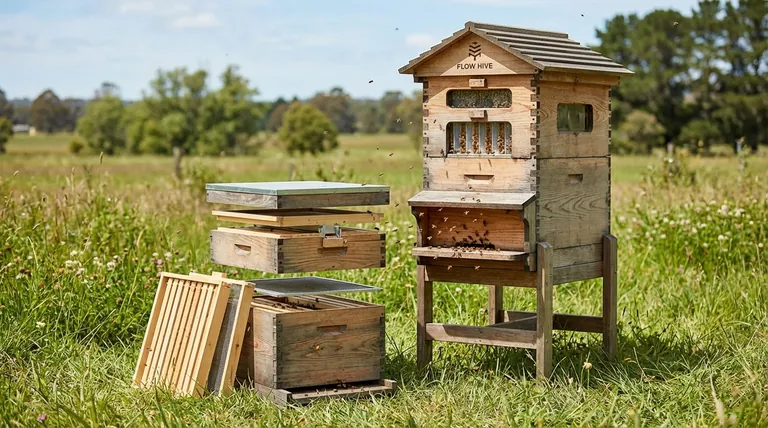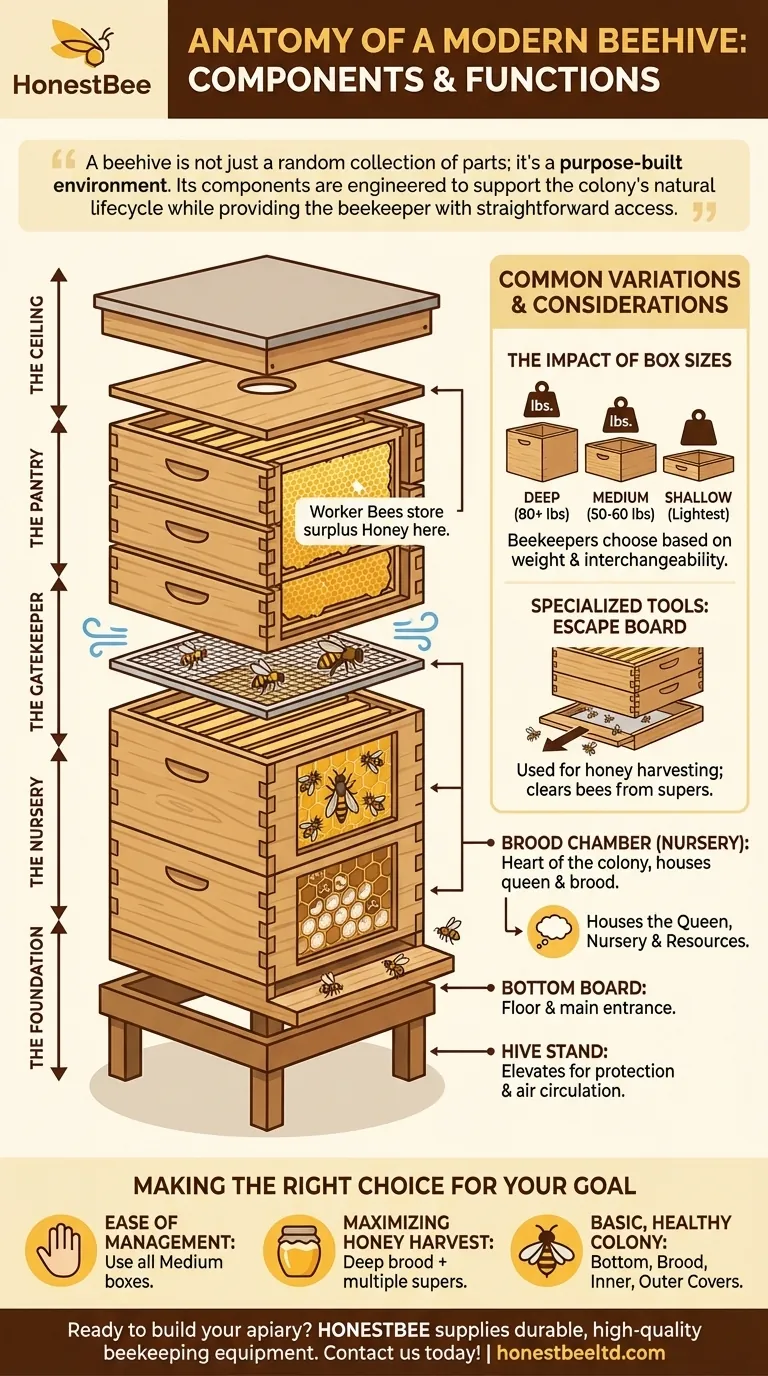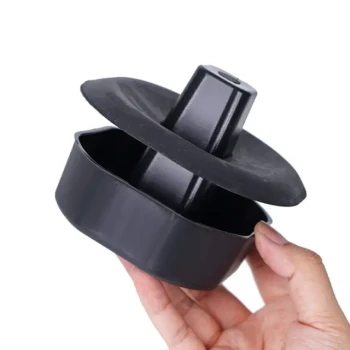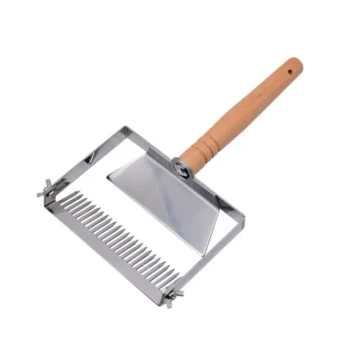At its core, a modern beehive is a modular system of stackable boxes and internal components. The primary parts include a hive stand, bottom board, one or more deep boxes called the brood chamber, a queen excluder, shallower boxes called honey supers, an inner cover, and a telescoping outer cover. Each piece is designed to serve a specific function for both the bee colony and the beekeeper.
A beehive is not just a random collection of parts; it's a purpose-built environment. Its components are engineered to support the colony's natural lifecycle while providing the beekeeper with straightforward access for inspection and honey harvesting.

Anatomy of the Hive: From the Ground Up
A beehive is assembled vertically, with each component playing a critical role in the system. Understanding the function of each part from the bottom up provides the clearest picture of how the colony operates within it.
The Foundation: Hive Stand and Bottom Board
The hive stand is the base that elevates the entire hive off the ground. This simple but crucial step protects the hive from moisture and pests while improving air circulation.
Directly on the stand sits the bottom board. This serves as the floor of the hive and features the main entrance for the bees to come and go.
The Nursery: Brood Chamber
The brood chamber (also called the hive body or deep box) is the heart of the colony. This is the largest box in the stack, and its primary purpose is to house the queen and the nursery.
Inside, the queen lays her eggs, and worker bees raise the young bees, known as brood. This chamber also stores the pollen and honey necessary to feed the developing bees. A strong colony may require two brood chambers.
The Gatekeeper: Queen Excluder
Placed directly on top of the brood chamber, the queen excluder is a flat screen with openings large enough for worker bees to pass through, but too small for the larger queen.
Its sole function is to keep the queen and her egg-laying activities confined to the brood chamber below. This ensures the honey stored in the boxes above is free of eggs and larvae.
The Pantry: Honey Supers
Honey supers are the boxes stacked on top of the queen excluder. This is where the worker bees will store the colony's surplus honey.
These boxes are typically shallower and lighter than the main brood chamber, making them easier for the beekeeper to lift when they are full of heavy honey.
The Ceiling: Inner and Outer Covers
The inner cover is a flat board that sits directly on top of the uppermost honey super. It provides an insulating dead air space and often has a small notch to create an upper entrance or ventilation point.
Finally, the outer cover (or hive lid) acts as the roof. It is a telescoping cover that fits over the top of the hive, protecting the entire colony from rain, sun, and other weather elements.
Common Variations and Considerations
While the basic components are standard, beekeepers make choices based on their goals, physical ability, and management style. Understanding these variables is key to a successful hive.
The Impact of Box Sizes
Honey supers and brood chambers come in three standard depths: deep, medium, and shallow. A deep box holds the most honey but can weigh over 80 pounds when full.
Medium boxes offer a popular compromise, holding a significant amount of honey while weighing a more manageable 50-60 pounds. Many beekeepers use medium-sized boxes for both brood and honey for total interchangeability.
Specialized Tools: The Escape Board
The escape board is a specialized piece of equipment used only during honey harvesting. It is an inner cover fitted with a one-way bee escape.
When placed below the honey supers for a day or two, it allows the bees to travel down into the brood chamber but prevents them from coming back up, clearing the honey supers of bees for easier collection.
Making the Right Choice for Your Goal
The modular nature of a hive allows you to configure it based on your primary objective.
- If your primary focus is ease of management: Consider using all medium-sized boxes for both brood and honey to create a system with interchangeable parts and lighter lifts.
- If your primary focus is maximizing honey harvest: Use deep boxes for the brood chamber to support a large colony and stack multiple honey supers on top during peak season.
- If your primary focus is a basic, healthy colony: The essential components are a bottom board, at least one brood chamber with frames, an inner cover, and an outer cover.
Ultimately, understanding how each component functions empowers you to manage your hive effectively for the health of the bees and your own beekeeping goals.
Summary Table:
| Component | Primary Function |
|---|---|
| Hive Stand | Elevates the hive off the ground for protection and air circulation. |
| Bottom Board | Acts as the hive floor and main entrance for the bees. |
| Brood Chamber | Houses the queen and the nursery for raising young bees (brood). |
| Queen Excluder | Keeps the queen confined to the brood chamber below. |
| Honey Supers | Where worker bees store surplus honey for harvest. |
| Inner & Outer Covers | Provide insulation and weather protection for the entire colony. |
Ready to build or expand your apiary with the right equipment? HONESTBEE supplies durable, high-quality beekeeping supplies and equipment to commercial apiaries and distributors through our wholesale-focused operations. Let us help you configure the perfect hive setup for your goals. Contact our expert team today to discuss your needs and get a quote!
Visual Guide

Related Products
- Automatic Honey Flow Beehive 4 Frame Mini Hive for Beekeeping
- In-Hive Dual Compartment Frame Bee Feeder for Targeted Colony Nutrition
- Professional Galvanized Hive Strap with Secure Locking Buckle for Beekeeping
- Honey Flow Garden Bee Hive Flow Hive Best Beehive for Beginners
- Wholesales Dadant Size Wooden Bee Hives for Beekeeping
People Also Ask
- What is the selling point of the Flow Hive? A Revolutionary, Stress-Free Honey Harvest
- How long does it take for bees to fill a Flow Hive? A Guide to Realistic Timelines
- How long does it take to get honey from a Flow Hive? Fast Harvesting Explained
- How does the Flow Hive simplify honey harvesting? The Revolutionary 'Honey on Tap' System Explained
- What are the benefits of a Flow Hive? Revolutionize Your Harvest with Ease and Care



















